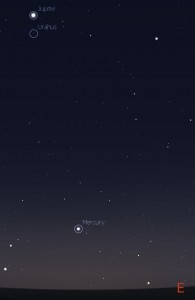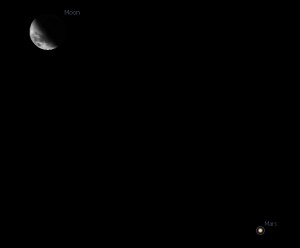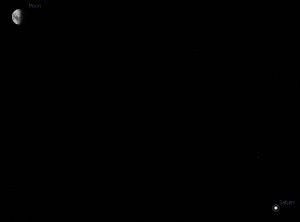These notes are intended to provide a casual skywatcher or someone already into amateur astronomy living in Brisbane, the Gold Coast and the Sunshine Coast with a short summary of what is happening in the night sky this week. Most of the information and finder charts will also be useful for observers elsewhere in Eastern Australia.
I am now including information on space missions as well. This week for instance, you will be able to watch live three spacewalks occurring at the International Space Station during the ongoing STS -132 Space Shuttle Atlantis mission to the International Space Station.
Keep in mind that you can follow this website automatically using Twitter and the sites RSS Feed.
Predictable Sky and Space Events
All week
The planets Venus, Mars and Saturn are easily visible to the unaided eye in the evening sky all week. The below chart is for Sunday 16 May 2010 for approximately 6.30pm AEST but is useful for the whole week.
Jupiter and Mercury continue to be easily visible above the Eastern horizon as morning twilight begins. The below chart is for Sunday 16 May 2010 for approximately 5.30am AEST but is useful for the whole week.
Moon furthest North (25.1 degrees)
Venus at perihelion.
The crescent Moon will be located above Venus in the evening twilight sky. Look low above the North West horizon. Refer to the below finder chart.
Monday 17 May 2010
At the time of preparing this article, the first spacewalk to be undertaken as part of the STS-132 Space Shuttle Atlantis mission to the International Space Station will begin at 10.15pm AEST on Monday evening. The spacewalk will be webcast live on NASA TV. The spacewalk is scheduled to end at 4.45 am on Tuesday morning.
If you are out walking early Monday morning in the Brisbane CBD, look above the North North East horizon at 5.15 am for a bright (-7) Iridium flare. The flare will only last 10 – 15 seconds but will be worth looking for.
Tuesday 18 May 2010
The Japan Aerospace Exploration Agency will launch a H-2A rocket containing the Akatsuki spacecraft and the IKAROS solar sail (from the Tanegashima Space Center, Japan) at 7.44 am AEST Tuesday morning. The launch will be webcast on the Internet. Further information on this launch can be found elsewhere on this site.
In the early evening sky, the waxing Crescent Moon located to the right of Pollux (one of the brightest stars in the ancient Greek Constellation Gemini The Twins). Early evening sky.
Wednesday 19 May 2010
Look to the right of the Moon in the early evening sky. The bright star is Mars.
At the time of preparing this article, the second spacewalk to be undertaken as part of the STS-132 Space Shuttle Atlantis mission to the International Space Station will begin at 9.45pm AEST on Wednesday evening. The spacewalk will be webcast live on NASA TV. The spacewalk is scheduled to end at 4.15 am on Thursday morning.
Thursday 20 May 2010
If you are out walking early Thursday morning on Mermaid Beach, look above the Eastern horizon (out to sea) at 6.11am for a bright (-6) Iridium flare. The flare will only last 10 – 15 seconds but will be worth looking for.
The bright star below and to the right of the Moon is Mars (evening sky). Refer to the below finder chart.
Moon at perigee. Moon will be closest to Earth in its orbit this month at 369,733 km.
Friday 21 May 2010
First Quarter Moon
If you are out walking early Friday morning in the Brisbane CBD, look above the Eastern horizon at 6.05am for a bright (-6) Iridium flare. The flare will only last 10 – 15 seconds but will be worth looking for.
The bright star below and slightly to the left of the Moon is Regulus (the brightest star in Leo the Lion). Evening sky.
At the time of preparing this article, the third spacewalk to be undertaken as part of the STS-132 Space Shuttle Atlantis mission to the International Space Station will begin at 9.15pm AEST on Friday evening. The spacewalk will be webcast live on NASA TV. The spacewalk is scheduled to end at 3.40 am on Saturday morning.
Saturday 22 May 2010
Look below and to the right of the Moon. The first brightest star your eyes will come to is in fact the planet Saturn. Evening sky. Refer to the below finder chart.
For Further Information
Planet and Moon Rise/Set Times
Planet and Moon rise/set times for 2010 can be found here on this website.
Customised Astronomy & Satellite Viewing information
Information on how to obtain customised astronomy & satellite viewing information for your location can be found here on this website.
Great Red Spot (Jupiter) viewing times
Information on when to see the Great Red Spot on Jupiter in 2010 can be found here on this website. Keep in mind that Jupiter is currently only visible in the morning sky.





Hi I have noticed a planet I beleive that is starts from the East then goes west. At around 11 pm the planet is south west in the high sky. The planet is white looking. And very bright. Do you know what planet this is. Some people have said that it is planet X. Is this true ? if not what planet is it. Thanks for your time.
Don,
The planet Jupiter is high above the North West horizon at around 11pm. It appears as a bright star to the unaided eye and there is no other bright star around it that you could mistake it for. It is the brightest ‘star’ in the night sky at present.
As an aside, there is no planet X. Planet X was invented as a hypothetical object to explain why the movement of the planets in the outer solar system didn’t move in the way predicted by mathematical models. When the Voyager 2 spacecraft passed Uranus in 1986, it allowed astronomers to ‘weigh’ Uranus (by noting how much the Voyager 2 spacecraft was moved from its flight path by the gravity of Uranus). They discovered that the weight (mass is the better term) differed from their models. Once they put the new weight/mass into the model, the discrepency disappeared. This removed the need to have a undiscovered planet (Planet X) out there somewhere in the solar system.